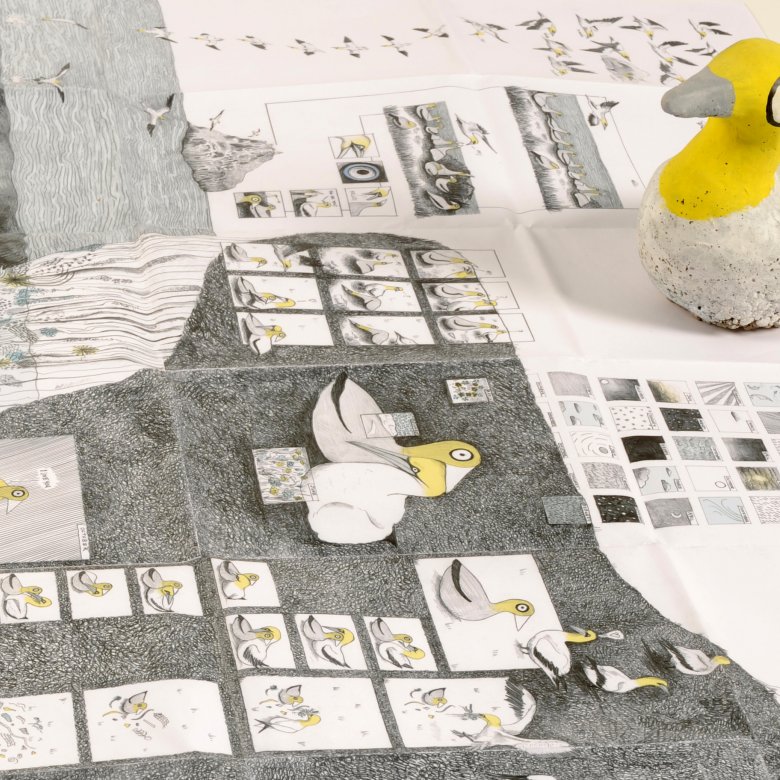Top 10 tips from a professional illustrator
15 June 2019

Tilly McKerrow, one of our Illustration tutors and – simultaneously – one of our MA Authorial Practice students, is living a life “completely immersed in illustration”.
As both teacher and student, Tilly has a unique perspective on university life. She told us: “Being a student again has reminded me about what it’s like to meet deadlines, receive grades and be on the receiving end of constructive feedback. I am reminded of the pressures of being a student and the complex work/life balance. It’s a very unique position I think. I hope it’s making me a better teacher, as I can relate to the student experience.”
The combination of postgraduate study and teaching practice certainly seems to be working well for Tilly’s creative work; she was recently shortlisted for an award at the World Illustration Awards, for an experimental illustrated book titled, The Lonely Gannet.
Tilly said: “I think, as lecturers, we should always be learning and pushing our skills. I learn from students all the time and I feel that teaching is a very two-way experience. I decided to do the Illustration MA as I wanted to challenge the way I work and learn from others.”
“My work can always be improved. How can I encourage someone to have an enquiring mind if I don’t have one myself?”, she added.
Here are Tilly’s top ten illustration tips:
1. Don’t force a ‘style’
I hear this time and time again, about students trying to find a ‘style’. When illustrators force a style, it can be shallow and often a copy of a fashionable style or popular illustrator at that time. However, fashions change and new illustrators should be pushing boundaries and creating new, fresh and exciting imagery.
Successful illustrators that stand the test of time have a unique voice and personality in their work. They don’t even call it a ‘style’, it is just an extension of who they are. This unique identity in their images only happens by making lots and lots of illustrations and letting an identity slowly evolve. It’s not something that can be rushed or forced.
2. Play!
The best way to learn and develop a visual language in illustration is to play. Try new materials that you have never used before, try them in a way you have never tried before, try them in a combination you have never attempted before.
It might look great, it might look terrible, but you will never know the potentials of the materials until you play with them and that’s when happy accidents occur. Have fun and that will translate into the work. The more materials and techniques you have in your toolkit the better.
3. Take risks
Try doing things out of your comfort zone. If you do that one thing that you’re very good at forever, life’s going to get very repetitive. It will allow you to become a reflective learner and learn from your mistakes, as well as building your visual skills.
To discover and become innovative, you need to do things that are new to you.
4. Approach a project from different angles
Great illustrators have great ideas but this is something they have to work towards, just like learning to paint or draw. Conceptual thinking and visual problem solving are fundamental skills that the illustrator learns from pushing their ideas and playing with possibilities.
However absurd or bizarre they may be, push your ideas to their limit. Invert them and come at the problem from a completely different angle. Don’t just go with your first idea without exploring other possibilities.
5. Draw every day
Try and always keep a sketchbook to hand, to draw observations or draw thumbnails of ideas that come to mind. This will boost your skills in drawing but also enable you to keep track of those great ideas that could come to you at any time of day or night.
Personally, my best ideas happen when I’m walking and I let my mind drift.
6. Observe
I can’t reiterate enough how important it is to observe and draw the world around you. You not only learn about form, light, tone and colour from looking and drawing but you also learn about life, nature and people. My imagination is fuelled and inspired by things I see or hear on a day-to-day basis.
If you open up all your senses and look for inspiration in the wider world, it will help you develop more interesting, imaginative, relatable and beautiful ideas and artwork.
7. Do it now, rest later
Procrastination is an illustrator’s worst enemy (trust me, I’ve been there).
A new white page in a sketchbook can be very daunting. Just start drawing and let the ideas and drawing lead. It doesn’t have to be perfect and it certainly won’t be if you leave it until the last minute. As a professional illustrator you will have tight deadlines that won’t allow for procrastination. The sooner you can tackle your time management skills, the better for yourself, your work and your career.
8. Try not to compare yourself to others
There are a lot of talented illustrators, artists and designers out there. Their work can be inspiring but also intimidating for a new illustrator. Try not to compare your work to theirs in a negative way. Their work is great because it is unique to them, just like yours is great because it’s unique to you.
If you lose confidence in your work and try to be someone you’re not, your work will lose its own identity and run the risk of being a copy of someone else’s.
9. Learn how to use social media constructively
Social media is useful to engage a wider audience in your work and to build your freelance business. However, don’t let it dictate what type of work you make, and try not to make decisions about your work depending on how many Likes you get.
Learn how to make those decisions reflectively and intuitively yourself.
10. Be critically engaged with the world
Last but by no means least, it’s important for an illustrator to be socially and critically engaged environmentally, politically, ethically, etc. We live in a very interesting and challenging time, and like journalism, illustration has the potential to address these issues and reach large numbers of people through a variety of platforms.
Illustration transcends language, it makes us think, it visually tells stories to people and about people of all ages and backgrounds; it addresses contemporary problems.
The pencil, like the pen, is a powerful tool.




